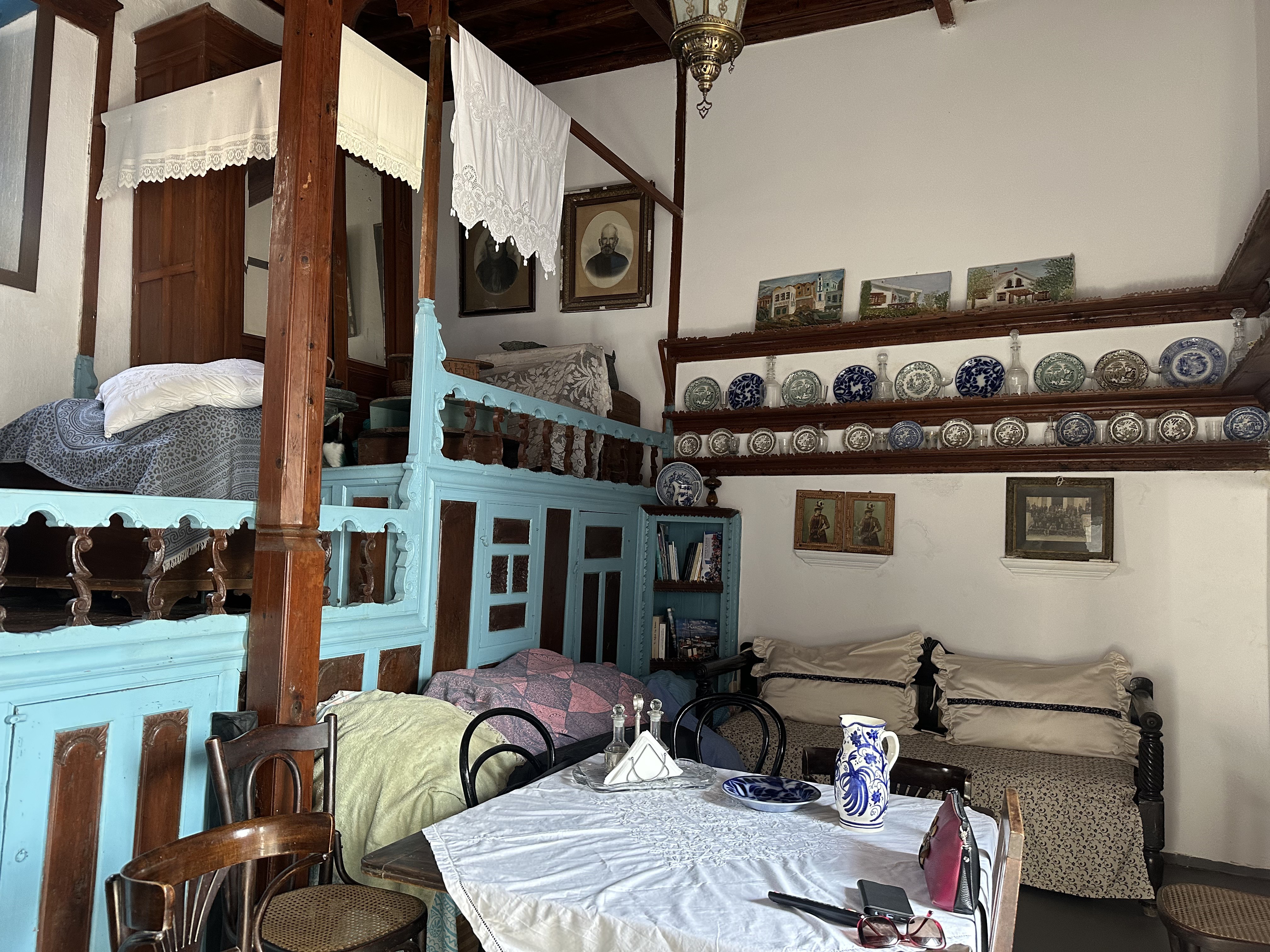Marie Tsakiri: tradition and transmission for five generations
.jpg)
Marie Tsakiri, a saleswoman in one of the souvenir stores on the island of Kassos, decided to change her life 25 years ago, going from chemical engineer to hotel manager and traditional dressmaker. What makes her special is that she has owned the largest traditional house on the island for five generations. She opened her doors to us to find out more about this family tradition and the life and history of Kassos.
Far from the future she had originally promised herself, Marie lives in Athens, but returns to the island of Kassos during the summer months. She seems so attached to the island from an early age, that in 2000 she decided to take over the family hotel and boutique alongside her mother. A sudden change of life, since she began her studies in Patras, northern Greece, as a chemical engineer at the Polytechnic, then moved into the environmental field in Athens. That year, Marie took the most important decision of her life, to become co-manager of the family hotel and open a clothing boutique on the island of her childhood, where she sells hand-designed items under the watchful eye of her mother, who was a stylist and taught her everything. In 2016, the year her daughter was born, she officially took over the family business on her own. Her dream: “That (her) daughter takes over,” she told us as we looked at her, sitting opposite her desk.
"Some locals don't appreciate the fact that there are so many tourists, but I think, on the contrary, that we need more tourists on the island."
Ancestral clothing transmission
In her boutique, Marie sells outfits inspired by what the Kassotes (the name given to the island's inhabitants, ndlr) wore during the 1824 massacre. She tells us that, at that time, the island's captain imported high-quality fabrics. These garments were strongly influenced by European costumes, such as taffeta, silk and brocade. The traditional Kassos garment, designed entirely by hand, consists of a jacket and a long skirt. The colors used are sober, dark blue, black, brown, burgundy or dark green. There were also dresses in a different style: cinched at the waist, with a tightly-fitting fabric belt in the back and around the belly. The sleeves were long, the cut varied a little from one garment to another, but the overall shape remained fairly similar. As for accessories, the women wore a veil with a fine lace trim at the end, known as “island teeth”. Men wore the “vraka”, a traditional pair of pants similar to those worn by the Christians of Crete, a white shirt with a black vest, and a “fessy”, a kind of black hat for the head, sometimes adorned with a typical fringe. This is the inspiration behind Marie's outfits, which she sells in her two boutiques in Kassos and Andros every summer.
.jpg)
A life between Kassos and Athens
Like many people, Marie only stays six months on Kassos, because once the tourist season is over, she admits there's not much to do... When asked how she felt about relations with the other inhabitants, she confides: "Everyone knows everyone here, it's a small island, but there's a lot of ‘gossip’ about each other. A lot of people take the liberty of getting involved in other people's lives, and that's not a good thing. There's also a lot of jealousy in this kind of place, especially between shopkeepers. We need to move forward hand in hand, all together, for the good of the island". For her part, going back to Athens for the other half of the year allows her to design new outfits and, above all, to spend more time with her family, something she can't really do when she has to spend six months in Kassos during the summer. A lifestyle that seems to suit her perfectly. Her daughter, who is out of school at the time, has even been able to join her and her father to help manage bookings for the hotel next door to the traditional family home.
A house that bears witness to history
It was at her home, in a house as historic as it is authentic, that the meeting continued. Recognized as one of the country's historic monuments by the Ministry of Culture, this house with its local architecture was designed to withstand the heat and earthquakes that are common in this part of the country. That's why it was built entirely of stone, with windows 4m high, providing shade at the front of the house, and air throughout the day. “In the early 1910s, the house was enlarged, with an upstairs bedroom, a small kitchen and the pebble courtyard,” she adds. The pebble courtyard is engraved with the initials “A.N.M”, corresponding to the names of Angelica and Nicolas Meleti, Marie's great-great-grandparents and the founders of the house. Tradition dictates that every 1st child takes over the family home. Marie, being an only child, logically took over the house after her mother. Her daughter, Angelica, took over for the 6th generation. Another tradition is that every daughter takes the name Angelica from her grandmother at birth. Except for her, who couldn't bear the name because “(her) father wasn't from Kassos, so the tradition couldn't happen. So she took her paternal grandmother's name.

Preserving the island, between tradition and the future
On the subject of life on the island, and in particular the influx of tourists, Marie puts forward her point of view, "some locals don't appreciate the fact that there are so many tourists, but I think, on the contrary, that we need more tourists on the island. I hope that in the coming years, the island will develop in this direction". In her opinion, it's important to preserve this island, not to transform or destroy it, because “what we have here is unique”.
Text : Dina Kadouri, Malvin Huin & Parmida Bayat
Photos : Parmida Bayat
